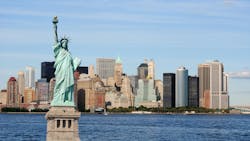About 94% of New York City buildings subject to Local Law 97 have either filed documents showing actions to comply with 2024 carbon emissions reductions targets, requested extensions until Dec. 31, or are discussing compliance pathways with the city Building Department, according to a report by Engineering News-Record.
Analysis by the Urban Green Council shows that 94% of multifamily buildings meet 2024 limits, while 93% of office buildings meet those requirements. However, lower 2030 targets are looming. According to data from 2023, the most recent year for which data is available, only 43% of buildings currently meet the 2030 requirements, including 49% of multifamily buildings and 50% of office buildings. Many New York City building owners will be facing the need for additional retrofit projects and savings strategies to meet the upcoming goals.
Who Has to Comply with Local Law 97?
A building’s square footage determines whether the building is required to comply with Local Law 97. Specifically, the law covers:
- Buildings that exceed 25,000 gross square feet
- Two or more buildings on the same tax lot that together exceed 50,000 gross square feet
- Two or more condominium buildings governed by the same board of managers and that together exceed 50,000 gross square feet
The city’s covered buildings list reflects the Department of Buildings’ records for compliance requirements, though it may not include all buildings required to comply with the law.
Why Do Buildings Have to Comply with Local Law 97?
Almost 70% of New York City’s carbon emissions come from fossil fuels, which are used to heat, cool, and power the city’s buildings, according to NYC Accelerator. Passed in 2019, Local Law 97 is part of the city’s plan to reduce those emissions and make the city carbon neutral by 2050.
The law includes annual fines for buildings that don’t comply with the emissions targets, beginning in 2025.
How Can Non-Compliant Building Owners Bring Buildings into Compliance with Local Law 97?
There are many resources available for building owners who know they won’t meet the targets, either now or in 2030. Consider these steps from NYC Accelerator:
- Understand your building’s situation. Look up your building in NYC Accelerator’s database to review building-specific compliance information, including projected penalties and potential savings.
- Explore compliance options. Certain types of buildings, like affordable housing developments or houses of worship, are eligible for alternative compliance pathways. Understand your options for complying with the law and determine what makes sense for your building.
- Get help from a compliance expert. NYC Accelerator offers a concierge service where a dedicated account manager (who is a compliance expert) works with you to marshal financial incentives, identify building improvements, and more.
- Apply for incentives and funding help. Check out NYC Accelerator’s curated list of incentive programs, financing options, and tax credits for New York City buildings and apply for the programs your building qualifies for.
About the Author
Janelle Penny
Editor-in-Chief at BUILDINGS
Janelle Penny has been with BUILDINGS since 2010. She is a two-time FOLIO: Eddie award winner who aims to deliver practical, actionable content for building owners and facilities professionals.

